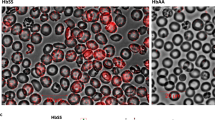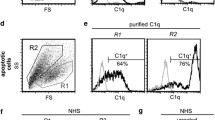Abstract
Intravascular haemolysis is a physiological phenomenon as well as a severe pathological complication when accelerated in various autoimmune, infectious (such as malaria) and inherited (such as sickle cell disease) disorders1. Haemoglobin released into plasma is captured by the acute phase protein haptoglobin, which is depleted from plasma during elevated haemolysis1. Here we report the identification of the acute phase-regulated and signal-inducing macrophage protein, CD163, as a receptor that scavenges haemoglobin by mediating endocytosis of haptoglobin–haemoglobin complexes. CD163 binds only haptoglobin and haemoglobin in complex, which indicates the exposure of a receptor-binding neoepitope. The receptor–ligand interaction is Ca2+-dependent and of high affinity. Complexes of haemoglobin and multimeric haptoglobin (the 2-2 phenotype) exhibit higher functional affinity for CD163 than do complexes of haemoglobin and dimeric haptoglobin (the 1-1 phenotype). Specific CD163-mediated endocytosis of haptoglobin–haemoglobin complexes is measurable in cells transfected with CD163 complementary DNA and in CD163-expressing myelo-monocytic lymphoma cells.



Similar content being viewed by others
References
Deiss, A. in Wintrobe's Clinical Hematology (eds Lee, G. R. et al.) 267–299 (Williams & Wilkins, Baltimore, 1999).
Zwaal, R. F. & Schroit, A. J. Pathophysiologic implications of membrane phospholipid asymmetry in blood cells. Blood 89, 1121–1132 (1997).
Rigotti, A., Acton, S. L. & Krieger, M. The class B scavenger receptors SR-BI and CD36 are receptors for anionic phospholipids. J. Biol. Chem. 270, 16221–16224 (1995).
Krieger, M. et al. Molecular flypaper, host defense, and atherosclerosis. Structure, binding properties, and functions of macrophage scavenger receptors. J. Biol. Chem. 268, 4569–4572 (1993).
Devitt, A. et al. Human CD14 mediates recognition and phagocytosis of apoptotic cells. Nature 392, 505– 509 (1998).
Oka, K. et al. Lectin-like oxidized low-density lipoprotein receptor 1 mediates phagocytosis of aged/apoptotic cells in endothelial cells. Proc. Natl Acad. Sci. USA 95, 9535–9540 (1998).
Sambrano, G. R., Parthasarathy, S. & Steinberg, D. Recognition of oxidatively damaged erythrocytes by a macrophage receptor with specificity for oxidized low density lipoprotein. Proc. Natl Acad. Sci. USA 91, 3265– 3269 (1994).
Fadok, V. A. et al. A receptor for phosphatidylserine-specific clearance of apoptotic cells. Nature 405, 85–90 (2000).
Wada, T., Oara, H., Watanabe, K., Kinoshita, H. & Yachi, A. Autoradiographic study on the site of uptake of the haptoglobin-haemoglobin complex. J. Reticuloendothel. Soc. 8, 185–193 (1970).
Buechler, C. et al. Regulation of scavenger receptor CD163 expression in human monocytes and macrophages by pro- and antiinflammatory stimuli. J. Leukoc. Biol. 67, 97–103 (2000).
Law, S. K. et al. A new macrophage differentiation antigen which is a member of the scavenger receptor superfamily. Eur. J. Immunol. 23, 2320–2325 (1993).
Pulford, K., Micklem, K., Law, S. K. & Mason, D. Y. in Leukocyte Typing VI. (eds Kishimoto, T. et al.) 1089– 1091 (Garland, New York, 1997).
Pulford, K. et al. A monocyte/macrophage antigen recognized by the four antibodies GHI/61, Ber-MAC3, Ki-M8 and SM4. Immunology 75, 588–595 (1992).
Van den Heuvel, M. M. et al. Regulation of CD163 on human macrophages: cross-linking of CD163 induces signaling and activation. J. Leukoc. Biol. 66, 858–866 (1999).
Wejman, J. C., Hovsepian, D., Wall, J. S., Hainfeld, J. F. & Greer, J. Structure and assembly of haptoglobin polymers by electron microscopy. J. Mol. Biol. 174, 343–368 (1984).
Bunn, H. F. Pathogenesis and treatment of sickle cell disease. N. Engl. J. Med. 337, 762–769 ( 1997).
Epstein, A. L. et al. Biology of the human malignant lymphomas. IV. Functional characterization of ten diffuse histiocytic lymphoma cell lines. Cancer 42, 2379–2391 (1978).
Hogger, P., Dreier, J., Droste, A., Buck, F. & Sorg, C. Identification of the integral membrane protein RM3/1 on human monocytes as a glucocorticoid-inducible member of the scavenger receptor cysteine-rich family (CD163). J. Immunol. 161, 1883– 1890 (1998).
Oliviero, S. & Cortese, R. The human haptoglobin gene promoter: interleukin-6-responsive elements interact with a DNA-binding protein induced by interleukin-6. EMBO J. 8, 1145– 1151 (1989).
Mitani, K., Fujita, H., Kappas, A. & Sassa, S. Heme oxygenase is a positive acute-phase reactant in human Hep3B hepatoma cells. Blood 79, 1255–1259 ( 1992).
Andrews, N. C. & Levy, J. E. Iron is hot: an update on the pathophysiology of hemochromatosis. Blood 92, 1845–1851 (1998).
Donovan, A. et al. Positional cloning of zebrafish ferroportin1 identifies a conserved vertebrate iron exporter. Nature 403, 776–781 (2000).
Resnick, D., Pearson, A. & Krieger, M. The SRCR superfamily: a family reminiscent of the Ig superfamily. Trends Biochem. Sci. 19, 5– 8 (1994).
Moestrup, S. K., Kaltoft, K., Sottrup-Jensen, L. & Gliemann, J. The human α2-macroglobulin receptor contains high affinity calcium binding sites important for receptor conformation and ligand recognition. J. Biol. Chem. 265, 12623– 12628 (1990).
Moestrup, S. K. et al. β2-glycoprotein-I (apolipoprotein H) and β 2-glycoprotein-I- phospholipid complex harbor a recognition site for the endocytic receptor megalin. J. Clin. Invest. 102 , 902–909 (1998).
Birn, H. et al. Characterization of an epithelial approximately 460-kDa protein that facilitates endocytosis of intrinsic factor-vitamin B12 and binds receptor-associated protein. J. Biol. Chem. 272, 26497– 26504 (1997).
Moestrup, S. K. & Gliemann, J. Analysis of ligand recognition by the purified α2-macroglobulin receptor (low density lipoprotein receptor-related protein). Evidence that high affinity of α2-macroglobulin-proteinase complex is achieved by binding to adjacent receptors. J. Biol. Chem. 266, 14011–14017 (1991).
Kozyraki, R. et al. The intrinsic factor-vitamin B12 receptor, cubilin, is a high-affinity apolipoprotein A-I receptor facilitating endocytosis of high-density lipoprotein. Nature Med. 5, 656–661 (1999).
Moestrup, S. K., Christensen, E. I., Sottrup-Jensen, L. & Gliemann, J. Binding and receptor-mediated endocytosis of pregnancy zone protein-proteinase complex in rat macrophages. Biochim. Biophys. Acta 930, 297–303 (1987).
Acknowledgements
We thank K. Lassen and A.-M. Bundsgaard for technical assistance; K. Pulford for providing the SU-DHL-1 lymphoma cell line; and M. Sommerlund for inspiration.
Author information
Authors and Affiliations
Corresponding author
Rights and permissions
About this article
Cite this article
Kristiansen, M., Graversen, J., Jacobsen, C. et al. Identification of the haemoglobin scavenger receptor. Nature 409, 198–201 (2001). https://doi.org/10.1038/35051594
Received:
Accepted:
Issue Date:
DOI: https://doi.org/10.1038/35051594
- Springer Nature Limited
This article is cited by
-
Unraveling the complex roles of macrophages in obese adipose tissue: an overview
Frontiers of Medicine (2024)
-
Ferroptosis and the bidirectional regulatory factor p53
Cell Death Discovery (2023)
-
Physiology and diseases of tissue-resident macrophages
Nature (2023)
-
Identification of immune infiltration-related biomarkers in carotid atherosclerotic plaques
Scientific Reports (2023)
-
Targeting ferroptosis opens new avenues for the development of novel therapeutics
Signal Transduction and Targeted Therapy (2023)





